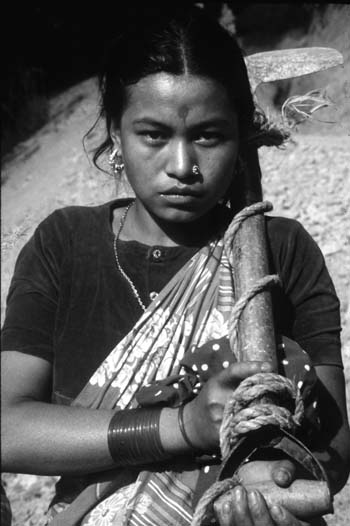
KEY FACTS
Population: 25 million
GDP per capita: US$ 240
Population below poverty line: 42%
Labour force by occupation: agriculture 81%, industry 3%, services 16%
Total land area: 147 181 sq km, bordering
China and India
Total arable land: 22%
Life expectancy: male: 60.1 years; female: 59.6 years
Literacy rate: male: 62%, female: 33%
Human Development Index: 140/177
(Source: UN; World Bank; CIA Factbook)

FAO IN NEPAL
This appeal for Nepal has been put together to prevent the country from sliding into a fullblown complex humanitarian emergency. Support to the food security of vulnerable populations is an important component of this appeal.
Background
Nepal is a least-developed low-income, food-deficit country with an estimated 31 percent of its 24.8 million people living below the poverty line. Poverty is largely concentrated in rural areas with most people directly or indirectly engaged in agriculture.
Nepal’s nine-year-old conflict between the Government and insurgent forces has resulted in thousands being killed and has forced the displacement and migration of tens of thousands more. In addition to the humanitarian challenges emerging out of the conflict, Nepal’s mountainous terrain means that it continues to be vulnerable to natural disasters including landslides, floods and earthquakes.
This appeal has been put together to prevent Nepal sliding into a fullblown complex humanitarian emergency. This is the first time that a Consolidated Appeal has been prepared for Nepal, addressing current humanitarian gaps not covered by planned development interventions. Every effort has been made to ensure that the activities proposed here are complementary to, and supportive of, other ongoing longer-term, development activities.
Needs analysis: Food security and agriculture sectors
Thirty-nine of Nepal’s 75 districts are estimated to be food-deficient with serious constraints on food access. Rates of child malnutrition are high, and only approximately 40 percent of rural households produce enough food to meet their year-round needs. The proportion of rural households needing to find supplementary income is greatest amongst landless people and small landholders. Migration to the larger towns, the Terai[1] and India for work is seriously affecting local wage labour and other established livelihood strategies.
With limited prospects for an end to the conflict, there is a continued need for activities that can bring short-term relief to vulnerable communities and strengthen their resilience and livelihood capacity in the mid- to longer-term. The aim must be not to create dependence on food assistance, but to assist improvements in agricultural production and the development of basic community assets.
Nepal average yields (notably for food crops) being among the lowest in South Asia, the agricultural rehabilitation strategy will centre on improving agricultural outputs. Considering such realities compounded with structural and economic limitations, assisting rural vulnerable groups in increasing farm production is still the most efficient intervention. This strategy will take into account the growing trend of the feminization of agriculture which is gradually becoming evident; within two decades (1981/1982-2002) the number of female-headed farm households has more than trebled and their proportion increased by nearly one third, while their average farm size remains much lower than that of male-headed households.
Particularly, the targeted households will need to be assisted in enhancing farm production by providing packages of critical inputs as seeds, fertilizers, agriculture tools and small livestock, together with technical assistance to enhance production and productivity for sustainability. Women farmers and female-headed households will be specially supported through micro-irrigation and agricultural inputs.
PROPOSALS
FAO RELIEF AND REHABILITATION ASSISTANCE
Funding
required: US$2 875 000
|
Strengthening food security of conflict affected households in Nepal |
Issues addressed: Under the current conflict situation, agricultural production has been facing the insufficient supply of agricultural inputs, such as seeds and fertilizer, and small livestock and technical service by the local government, which has made the food security situation more vulnerable.
Objectives: To strengthen the disrupted agricultural livelihood activities of vulnerable families affected by conflict, through the provision of agriculture inputs, livestock, veterinary services and technical know-how, and thereby reduce their dependency on external food assistance.
Activities: Support to organize self-help groups; provision of inputs for agricultural livelihood support, such as seeds, fertilizer, tools, livestock and veterinary services; training of target groups, implementing partners and government counterparts on sound agricultural practices, crop productivity, nutrition, disaster preparedness; participatory monitoring and evaluation.
Beneficiaries: 80 000 households (including 20 000 female-headed households) in 20 districts.
Implementing partners: National and local level NGOs, Ministry of Agriculture and Cooperatives.
Duration: January 2006 - December 2006.
Funds requested: US$ 2 000 000.
|
Strengthening the capacity of vulnerable women farmers for household food security, improved nutrition and health |
Issues addressed: Women farmers have been undertaking greater responsibility in managing their livelihoods in addition to their regular household chores as more men have migrated for job opportunities due to the conflict. However, women farmers often lack knowledge in agricultural production and nutrition. Furthermore, basic infrastructure still needs to be developed to enable them to take up added responsibilities.
Objectives: To strengthen the technical and institutional capacity of vulnerable women farmers on irrigation and water resources management and increase their access to water and other productive resources in a sustainable manner; To link with longer-term development perspectives in order to restore livelihoods and ensure sustainability.
Activities: Support to organize self-help groups; irrigation/water management needs analysis; provision of micro-irrigation systems; provision of agricultural production inputs; training of target groups, implementing partners and government counterparts on sound agricultural practices, crop productivity, nutrition; participatory monitoring and evaluation.
Beneficiaries: 10 000 female-headed households in 5 districts.
Implementing partners: National and local level NGOs, Ministry of Agriculture and Cooperatives, Ministry of Water Resources.
Duration: January 2006 - September 2007.
Funds requested: US$ 875 000.
|
[1] The Nepalese Terai region
consists of a 26 km to 32 km wide belt of alluvial and fertile plain in the
southern part of the country. |